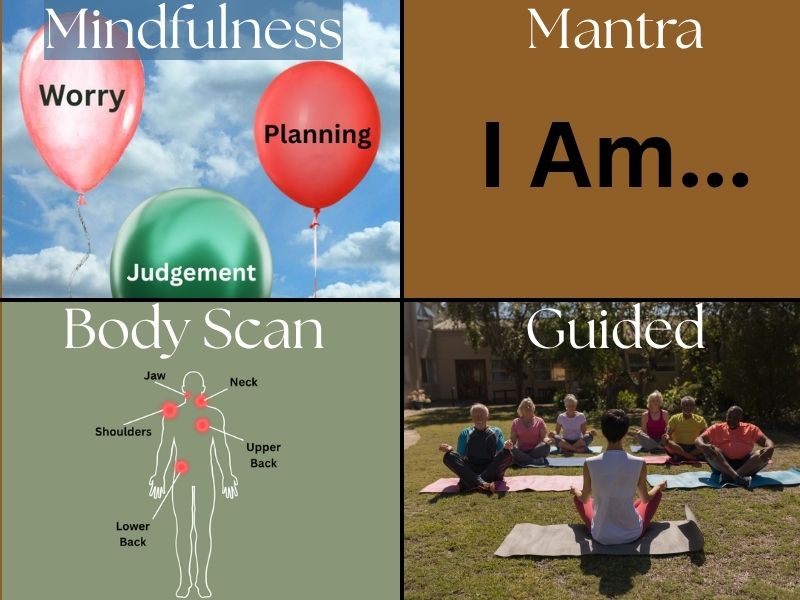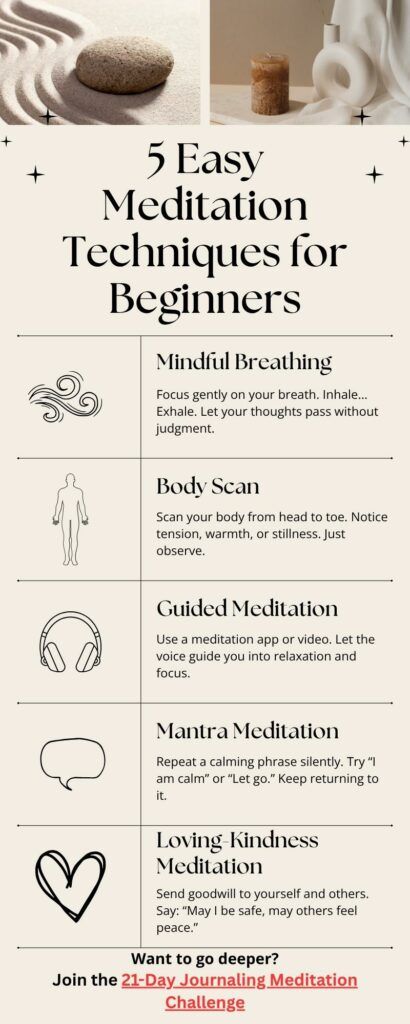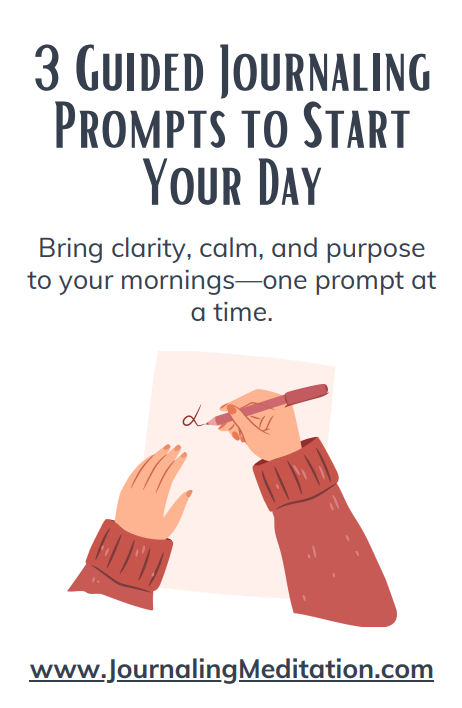Updated: June 2025

Starting a meditation practice shouldn’t feel intimidating. With the right guidance, even just 5 minutes of quiet time a day can begin to shift how you respond to stress, connect with your emotions, and build mindfulness in everyday life. This guide on meditation for beginners will walk you through some of the tools and techniques to overcoming common challenges. Whether you’re completely new or trying to make your practice stick this time, you’ll find simple strategies that make meditation easier to begin and to keep going.
💡 P.S. Want a free guided meditation and journaling prompt to get started? Grab yours here.
(This post contains affiliate links. If you make a purchase through these links, I may earn a commission at no extra cost to you.)
What Is Meditation—and Why Does It Matter?
In its simplest form, meditation is the practice of training your attention and awareness. Some of the approaches involve focusing on the breath, repeating a mantra, or observing thoughts without judgement. The goal isn’t to stop thinking, but rather to simply observe what’s happening without getting caught up in it or attaching yourself to it.
Over time, meditation can help you:
- Feel calmer in the middle of stress
- Improve focus and productivity
- Strengthen emotional regulation
- Sleep better
Even just 5–10 minutes a day can be enough to start seeing benefits.
Different Types of Meditation for Beginners

If you’re just getting started, it helps to know that there’s more than just one way to meditate. Here are a few beginner-friendly practices:
- Involves focusing on breath and observing thoughts without judgment
- Great for reducing stress and increasing focus
- Breath is an anchor to help bring your thoughts back
Guided Meditation
- Led by a teacher or narrator that walks you through a specific visualization or theme
- Perfect for beginners just starting out
- Free options on YouTube
Loving-Kindness Meditation
- Centers on sending goodwill to yourself and others through phrases like “May I be safe.”
- Builds compassion and softens critical thinking
- You are worthy of your own loving kindness
Mantra Meditation
- Repeating a word or phrase silently to yourself to focus attention
- Can help quiet racing thoughts
- Examples: “I am at peace,” “I release… ,” or “I am enough”
How to Set Up for Meditation Success
1. Choose a Quiet, Calm Spot
Pick a space where you won’t be interrupted. It doesn’t have to be a special room, just a spot where no one will go. Add a pillow, soft lighting, maybe a plant or candle. Smell can help induce calm, so perhaps add some lavender.
2. Gather a Few Tools (Optional, but Helpful)
While all you need is yourself to start meditating, a few simple tools can help make it more enjoyable and maybe even help create some anticipation.
Here are a few of my favorites (Amazon affiliate links):
- Comfortable meditation cushion: Helps support your back and hips
- Noise-canceling headphones: Perfect for guided meditations or listening to soft ambient music
- A journal: A next level option for writing down reflections for deeper self understanding
👉 Check out my full list of recommended meditation tools for beginners.
3. Pick a Time and Stick to It
Morning or evening often work best. One is often associated with getting ready while the other is to empty out the negative. Try to keep consistent and meditate at the same time each day. Even if it’s only 3-5 minutes, that’s enough to start building the habit. Consistency beats length when you’re starting out.
Beginner Meditation Techniques: Where to Start
When just starting out, you have no idea what is out there. Here are a few techniques you can experiment with and hopefully one will resonate with you. If not, don’t give up. There are plenty more techniques to explore.
Mindful Breathing
- Sit comfortably and close your eyes.
- Breathe in slowly through your nose… and exhale gently through your mouth.
- Notice where the breath is most vivid—your chest, belly, or nose.
- When your mind wanders (and it will), gently guide your attention back to your breath.
Try this for 2–3 minutes to begin, and slowly build up to 10+.
Body Scan
- Sit or lie down comfortably.
- Bring your attention to your feet and begin moving that attention upward, body part by by body part.
- Simply notice any sensations; tightness, warmth, tingling without needing to change them.
This technique can be especially helpful before bed or after a long, stressful day.

Guided Visualization
Choose a short video, audio track, or app that walks you through a scene. Like walking through a forest or relaxing on the beach. Let the narration guide your breath and body into relaxation.
Want to try it now? This Guided Meditation For Grounding is free to watch on YouTube.
Tips to Make Meditation Easier (and More Effective)
- Start small: Don’t try to start meditating for 20 minutes. Begin with just 3–5.
- Don’t judge your thoughts: Meditation isn’t about “emptying your mind.” It’s about noticing.
- Use your breath or mantra as an anchor: When thoughts start wandering, these give you something to return to.
- Keep a journal nearby: Writing after meditating helps you reflect and actually see your growth.
- Be consistent: Even just 3 minutes a day creates a foundation for habit.
Common Meditation Struggles—and How to Move Past Them
“I can’t stop thinking”
No one can! That’s not the point. The practice is to only notice thoughts and allow them to pass through, then return to the breath. Each return strengthens your awareness.
“I keep getting distracted”
Try noise-canceling headphones or soft music. But sometimes you may have to incorporate them into your routine and practice not labeling them.

“I forget to meditate”
Set an alarm on your phone. Tie it to an existing habit (like brushing your teeth or making coffee). But if you’re really serious about it, you can start anytime you remember.
How to Take Meditation Deeper Over Time
1. Combine Meditation with Journaling
This can be a powerful addition to any meditation practice. After each session, spend 2–3 minutes writing what you noticed.
Maybe something like:
- “What did I feel in my body today?”
- “What recurring thoughts came up today?”
✍️ Want 3 free morning journaling prompts? Get them here.
2. Try a 21-Day Challenge
Daily structure can help turn meditation from a task into a habit. My 21-Day Journaling & Meditation Challenge includes a guided video + journaling prompt every day for 21 days. It’s designed for busy beginners who want a gentle and supportive start and are willing to invest 10 minutes a day for it.
3. Explore Other Styles
As you build confidence, try silent meditation, walking meditation, or sound bowl meditations to deepen your experience and expand your awareness.
Meditation for Beginners: Final Thoughts
Meditation is less about doing it “right” and more about showing up. Be patient. Be curious. And remember, every breath is a new beginning.
Your mind will wander. Your body will fidget. But that’s okay. Just come back to the next breath, the next moment, a new beginning.
If you’re ready to start your journey, grab your free prompts, light a candle, and sit or lie down. You don’t need to wait for the perfect moment. You just need to start.
👇 Let’s Talk
Have you started meditating yet? If not, what’s been your biggest challenge? If so, what’s your biggest win? Please share below! I’d love to hear from you.o far? Please share your thoughts and experiences in the comments below and happy meditating!






